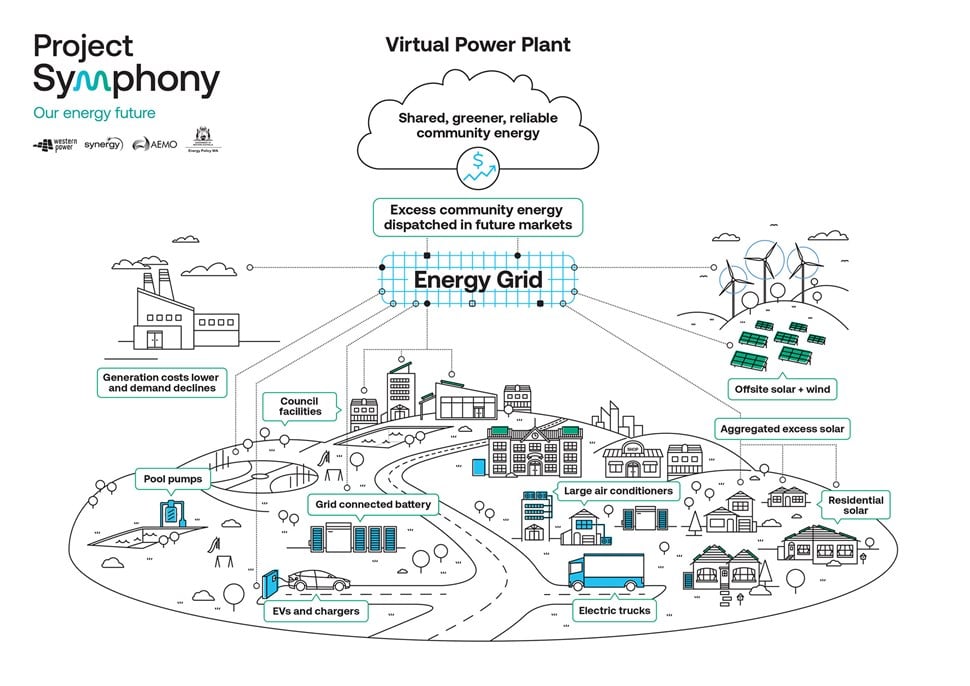
A US$25 million virtual power plant (VPP) programme has been launched in Perth, Western Australia, while in the US, technology providers Enphase, Sunverge and LG have announced their involvement in VPPs in Arizona and California.
VPPs aggregate together large numbers of distributed energy resource (DER) assets to operate in coordination. Typically utilising customer-sited solar and smart appliances, battery storage is often the key technology that enables DER fleets to perform grid services like frequency response and energy services like providing peak capacity when the energy network needs it most.
Enjoy 12 months of exclusive analysis
- Regular insight and analysis of the industry’s biggest developments
- In-depth interviews with the industry’s leading figures
- Annual digital subscription to the PV Tech Power journal
- Discounts on Solar Media’s portfolio of events, in-person and virtual
Project Symphony, Western Australia
In Perth, the Project Symphony VPP project is being rolled out to orchestrate the use of around 900 DER assets at 500 homes and businesses, aggregating electricity generated and dispatching excess supply to the network as required.
The pilot is being carried out in areas which have a high uptake of rooftop solar. A third of Western Australian households have solar, adding up to almost 2GW and nearly 50% of homes in the selected areas of Harrisdale and Piara Waters have solar installed.
State government-owned electricity network provider Western Power said that the high proportion of decentralised DER “poses a risk to the stability of the state’s power network,” caused by low or fluctuating energy demand on the local grid.
The VPP will enable DER assets to be integrated more efficiently into the grid, lowering system costs for consumers, free up network capacity to enable more renewables onto the grid and pave the way for similar developments in the state.
Western Power, utility company Synergy and the Australian Energy Market Operator (AEMO) are conducting the AU$35.5 million (US$25 million) two-year pilot project. The Western Australia government and AEMO have secured AU$26.9 million of the funding required, while the remaining AU$8.6 million is coming from the Australian government via the Australian Renewable Energy Agency (ARENA).
The pre-commercial pilot can be expanded at a later phase through third-party aggregators. The project will create a framework for participating resources to access the Wholesale Electricity Market (WEM).
ARENA said last week that its funding will go towards developing, integrating and testing software systems to manage energy distribution, market operation and market aggregation, underpinning the monitoring and coordination of DER assets.
Meanwhile the overall project will be used to identify where and how much investment will be required to expand the role of distributed energy while supporting the security and reliability of electricity networks.
The programme is one of the actions set out in a Distributed Energy Resources Roadmap from the Western Australian government. Also included in that roadmap is the rollout of ‘community batteries’, which will be 1.34MW shared use battery storage systems in Perth’s suburban areas. Western Power has just launched a consultation to determine the best locations for those.
Sunverge, LG partner on California VPP pilot
Battery storage and VPP company Sunverge is working with LG Electronics on a pilot programme in the service area of California investor-owned utility (IOU) Pacific Gas & Electric (PG&E).
The partners will combine LG energy storage systems and Sunverge’s DER software platform to aggregate solar PV-plus-storage for 100 homes in PG&E’s service area. Power engineering company Eaton will provide energy management circuit breakers.
Sunverge claimed it will be one of the US’ first pilot programmes to incorporate load control as well as control of solar and storage “holistically,” which company CEO Martin Milani said would create value “on both sides of the meter,” while “helping utilities transition to more resilient and flexible distribution grids”.
“The project will evaluate a number of program design elements, including time of use and real-time pricing signals, load shaping and shifting, event-based demand response as well as contingency reserve, frequency regulation and voltage support ancillary services,” Milani said.
The project is expected to be up and running at selected homes in Northern and Central California early next year.
“Utilities are increasingly seeing the value that distributed clean energy resources, combined with energy storage and intelligent control and orchestration, can add real value to consumer, communities, grid and the utilities themselves,” LG Electronics USA energy VP Stephen Hahm said, adding that LG will also supply solar PV equipment to some households taking part.
Homeowners can get up to US$3,750 for joining Arizona VPP
While VPPs are of benefit to utilities and grid operators by enabling them to monitor and control the energy resources in their service areas, programmes are also increasingly being designed to incentivise participation for homeowners.
This can result in a reduced cost for having back up power available, or improved payback time for home energy systems which can make purchases more attractive.
Enphase Energy, best known for solar microinverters and monitoring technologies but also a manufacturer of home battery storage systems, said it is taking part in a pilot programme which offers homeowners up to US$3,750 each to join.
The residential battery pilot grid services scheme will give customers with Enphase IQ Battery systems in the service area of utility Arizona Public Services (APS) US$500 per installed kilowatt of battery capacity a one-off upfront payment for sharing data related to the battery system’s operation with APS.
This applies up to a capped level of US$2,500, while customers that allow APS to use the energy stored in their battery systems on demand can qualify for the same incentive, plus an extra payment of up to US$1,250.
APS expects to use those batteries up to 100 times per year and participants must be residential customers on a time-of-use service plan or grandfathered solar energy rate service plan. It is being opened to new battery customers, not those with existing systems.

